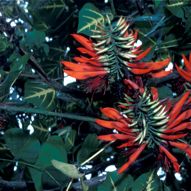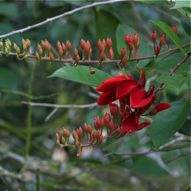We have earlier posted a list of fig plants (Ficus spp.) that attract hordes of birds when they are figging LINK; also, a list of trees whose fruits attract birds LINK. The current post gives a list of plants that attract nectar-feeding bird, like the Olive-backed Sunbird on the left.
These plants produce flowers that secrete copious nectar that in turn attract nectivorous birds like sunbirds, flowerpeckers, spiderhunters and more. The nectar at the same time attracts insects like ants, butterflies, moths and bees, that in turn attract insectivorous birds. The following list is just a selection. There are many more trees, shrubs and climbers that can be used and mistletoe is an excellent example. These will be dealt with in subsequent posts.
1. Heliconias (Heliconia spp.) are made up of a wide array of species, cultivars and hybrids, many with spectacularly beautiful flowers. These are exotic ornamental shrubs recognised by their banana-like leaves. They are heavy feeders and spread aggressively by underground rhizomes. The latter can be controlled somewhat by growing them in large containers. Mainly Tropical American in origin, they are pollinated by hummingbirds and nectar-feeding bats in their countries of origin. In the tropics however, sunbirds take the place of hummingbirds. And heliconias are a strong magnet for sunbirds LINK.
2. Torch ginger (Etlingera elator) is a large erect herbaceous plant made up of tall stems. The flowering heads, borne on much shorter and slender stems, bear red or pink flowers attracting sunbirds and spiderhunters LINK.
3. Yellow saraca (Saraca thaipingensis) is a small to medium-sized tree with a wide spreading crown. The pinkish-yellow flowers that turn deep yellow are in large bunches growing from the main trunk and branches. The young, creamy leaves hang limply from the ends of branches. It is a handsome tree indeed. Sunbirds flock to it when in bloom to feast on the nectar LINK. There are a few other species that can also be planted to attract nectivorous birds.
4. Bottlebrushes (Callistemon spp.) are medium-sized trees with brightly coloured flowers borne along the ends of branches looking like bottlebrushes. Sunbirds flock to these flowers for their nectar LINK.
5. Golden penda (Xanthostemon chrysanthus) is a medium-sized tree that tends to flower gregariously. Their attractive yellow flowers in bunches attract sunbirds, hanging parrots, lorikeets, bulbuls and mynas in urban locations LINK. In rural areas, the tree would attract more nectar-feeding birds other than sunbirds.
6. Pink powderpuff (Calliandra surinamensis) is a shrub with pink and white flowers in dense heads. Flowers are prominent in their long stamens and are produced throughout the year.
7. Firecracker plant, also known as coral plant (Russelia equisetiformis) is a shrub that can grow to a height of 1.5 metres (below left). It has long slender, drooping stems with tiny leaves and bright red flowers. It is best grown raised where its branches can trail over the wall or in hanging containers. Free flowering, the flowers attract sunbirds.
8. Coral tree (Erythrina variegata) is a popular roadside tree, medium-sized, with leaves that have broad yellow stripes along the veins (above centre). Flowers are orange-crimson, attracting nectar-feeding birds.
9. Cockscomb tree (Erythrina crista-galli) is a smaller version of the coral tree whose leaves do not have the yellow stripes (above right). Flowers are dark crimson and similarly attract nectar-feeding birds.
10. Umbrella tree (Schefflera actinophylla) is a small tree that tends to be invasive. The fruits attract frugivorous birds while the flowers attract birds like sunbirds, flowerpeckers, orioles, white-eyes, mynas and bulbuls LINK.
11. Horseradish tree or drumstick (Moringa oleifera) is much loved by Indians who plant this smallish and rather straggly tree for their edible leaves, flowers and fruits. The young pods make an excellent curry dish when cooked with dal. Flowers attract nectivorous birds like ioras LINK.
12. Straits rhododendron or sendudok (Melastoma malabathricum) is a shrub common along the wayside. You need not grow this plant as birds will invariably bring the seeds to your garden. Just leave a few to develop naturally in one corner and birds will come for the nectar and fruits LINK.
YC Wee
Singapore
October 2011













9 Responses
Does Sendudok have nectar? It seems some Melastomaceae species are nectar-less!
Havent seen SB or SBF on flowers, but they come for the fruits beside the flowers.
The flower probably has some nectar. After all, it attracts ants. And Khew of Butterfly Circle has picture of the flower being visited by a butterfly. However, the flower does not secrete enough nectar to attract birds.
Hi YC! I finally managed to find a healthy-looking firecracker plant at a nursery in Bedok! The 2nd day after I had taken it home, I was immediately visited by 3 sunbirds – 2 were the olive-backed one and the third one had a shimmery blue throat! They seemed to be searching for a suitable nest site (as the plant I bought had no flowers, so it couldn’t be for the nectar). Thanks so much for the great advice and I hope to acquire more bird-attracting plants over time!
P.S. Do bird- and bee-attracting plants also simultaneously attract other insects? I found a dead lesser-banded hornet on my balcony some time ago (1-2 months before I got the firecracker plant). I get a lot of Asian honey bees (about 10 altogether at any one point of time throughout the day) due to my numerous constantly flowering basil plants. Will the presence of foraging bees attract hornets?
Good for you. Let’s hope the sunbirds nest in your firecracker plant. Each species of plant has it own complements of fauna that include insects, reptiles, birds and mammals.
No idea what conditions attract hornets. Maybe ideal nesting sites (whatever that may be). I don’t think bees attract hornets or vice versa.
Thanks again! I hope the sunbirds decide to nest there too! BESG has been an extremely valuable resource especially to us living here in Asia. Hope to see more great posts about plants/insects/birds in the years ahead!
Well done. Great useful information. Thank you for sharing.
Thanks for the tips. May I know which of them is not too large and grow slower than others? I have limited space outside window, and recently seen sunbirds pretty often. They appear to be collecting nesting material from my neighbours, am thinking to plant something to attract them.
Firecracker plant is ideal – see https://besgroup.org/2017/06/17/sunbird-probing-78-flowers-in-5-minutes-for-nectar/